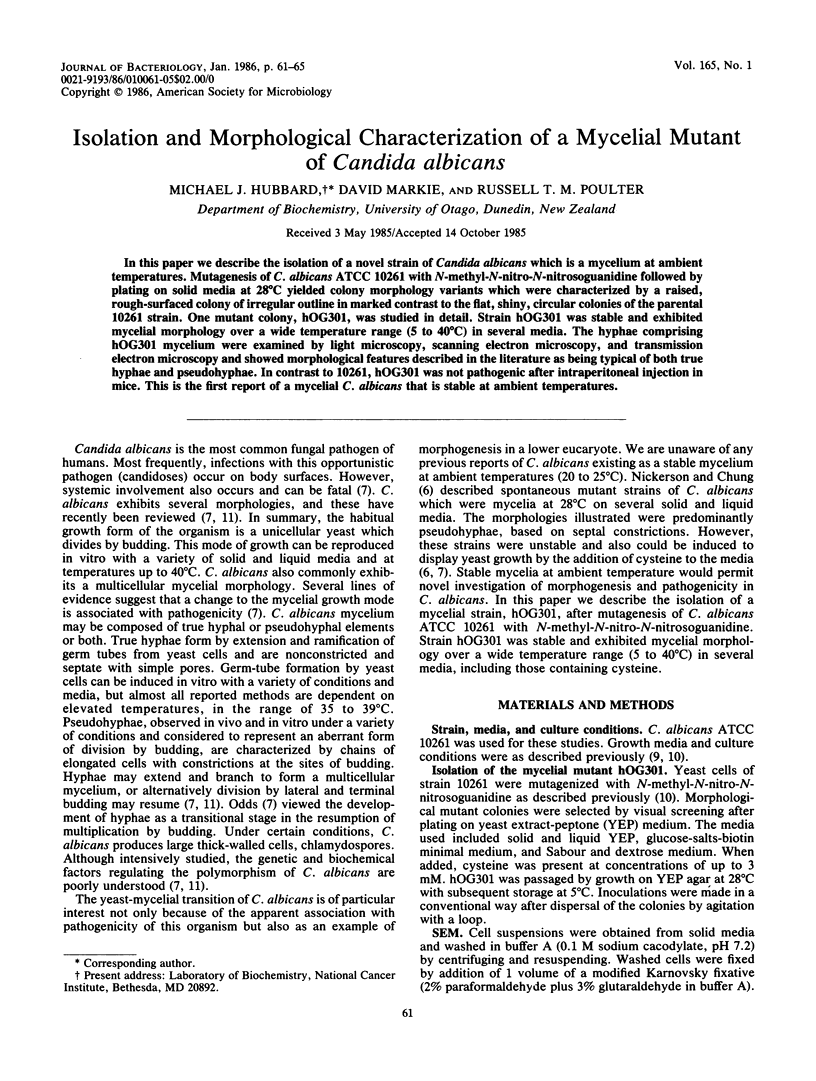Isolation and morphological characterization of a mycelial mutant of Candida albicans (original) (raw)
Abstract
In this paper we describe the isolation of a novel strain of Candida albicans which is a mycelium at ambient temperatures. Mutagenesis of C. albicans ATCC 10261 with N-methyl-N-nitro-N-nitrosoguanidine followed by plating on solid media at 28 degrees C yielded colony morphology variants which were characterized by a raised, rough-surfaced colony of irregular outline in marked contrast to the flat, shiny circular colonies of the parental 10261 strain. One mutant colony, hOG301, was studied in detail. Strain hOG301 was stable and exhibited mycelial morphology over a wide temperature range (5 to 40 degrees C) in several media. The hyphae comprising hOG301 mycelium were examined by light microscopy, scanning electron microscopy, and transmission electron microscopy and showed morphological features described in the literature as being typical of both true hyphae and pseudohyphae. In contrast to 10261, hOG301 was not pathogenic after intraperitoneal injection in mice. This is the first report of a mycelial C. albicans that is stable at ambient temperatures.

Images in this article
Selected References
These references are in PubMed. This may not be the complete list of references from this article.
- Drewe J. A. The ultrastructural appearance of Candida albicans with different fixatives. Med Lab Sci. 1981 Jul;38(3):237–244. [PubMed] [Google Scholar]
- Ghosh B. K. Grooves in the plasmalemma of Saccharomyces cerevisiae seen in glancing sections of double aldehyde-fixed cells. J Cell Biol. 1971 Jan;48(1):192–197. doi: 10.1083/jcb.48.1.192. [DOI] [PMC free article] [PubMed] [Google Scholar]
- Hubbard M. J., Poulter R. T., Sullivan P. A., Shepherd M. G. Characterization of a tetraploid derivative of Candida albicans ATCC 10261. J Bacteriol. 1985 Feb;161(2):781–783. doi: 10.1128/jb.161.2.781-783.1985. [DOI] [PMC free article] [PubMed] [Google Scholar]
- Joshi K. R., Gavin J. B., Wheeler E. E. A scanning electron microscopic study of the morphogenesis of Candida albicans in vitro. Sabouraudia. 1973 Nov;11(3):263–266. doi: 10.1080/00362177385190531. [DOI] [PubMed] [Google Scholar]
- Odds F. C. Demonstration of a septal pore in budding Candida albicans yeast cells. Sabouraudia. 1984;22(6):505–507. [PubMed] [Google Scholar]
- Poulter R., Hanrahan V., Jeffery K., Markie D., Shepherd M. G., Sullivan P. A. Recombination analysis of naturally diploid Candida albicans. J Bacteriol. 1982 Dec;152(3):969–975. doi: 10.1128/jb.152.3.969-975.1982. [DOI] [PMC free article] [PubMed] [Google Scholar]
- Poulter R., Jeffery K., Hubbard M. J., Shepherd M. G., Sullivan P. A. Parasexual genetic analysis of Candida albicans by spheroplast fusion. J Bacteriol. 1981 Jun;146(3):833–840. doi: 10.1128/jb.146.3.833-840.1981. [DOI] [PMC free article] [PubMed] [Google Scholar]